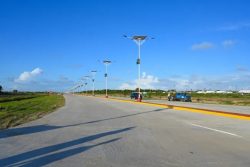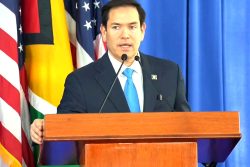In this article I propose to trace the earliest history of local government in colonial British Guiana. Indeed, our country Guyana, the former British Guiana, has a long and chequered history of local government.
Prior to 1838, the year when the apprenticeship scheme was terminated and full freedom attained, the capital city of Georgetown had some aspect of local government. For example, Ordinance No. 2 of 1837 created the Mayor and Town Council of Georgetown. In a way this development was an emulation of the English Municipal Corporations Act of 1835. In June, 1837 a Mayor’s Court was established and it was presided over by the Mayor and two of his councillors and with summary jurisdiction that embraced the town.
Following emancipation and the termination of the apprenticeship system there was a marked exodus of freed slaves from the plantations. This was really the beginning of the village movement as the ex-slaves who left the plantations looked to the land and agriculture for their very survival. A number of reasons could be advanced for this development. For decades the plantation had symbolized degradation, demoralization and dehumanization of the victims and with the attainment of full freedom they wanted to rid themselves of planter class economic, social, cultural and political domination. They also wanted to enjoy the satisfaction of ownership and to establish an economic base for themselves through the cultivation of cash crops. In short, the exodus was a reaction to the plantation economy, to monocrop dependence and to harsh metropolitan control.
Subsequently, freed slaves promptly bought out abandoned coffee and sugar estates from their original owners. The first decade after the termination of apprenticeship witnessed a steady stream of freed labourers from the estates to the newly created villages. This remarkable development is easily borne out in the statistical evidence which put the Negro population on the sugar estates at 19,939 as against 42,755 in the villages by 1850.
With the emergence of the communal and proprietary villages in post-emancipation nineteenth century, British Guiana, villagers had to address several problems such as water control in the form of sea defences, drainage and irrigation and empolderment and also road repairs and bridges. There was periodic flooding and such was the situation that an undrained village at the time was aptly described as “an inhabited swamp”.
During the initial stage of the village movement Gover-nor Henry Light adopted a laissez-faire approach. This seemingly negative attitude could be seen as giving tacit support to the plantocracy in thwarting the efforts of villagers. On the other hand, the then administrator might have adopted such a cautious stand since he was at that point in time arousing planters’ indignation over constitutional and other related matters.
The early village movement came under a more or less co-operative management system. In other words, a committee of management was instituted under a Chairman, a Vice-Chairman, a Treasurer, a Secretary and not less than seven committee members.
These were the acknowledged village leaders who exercised authority that flowed from voluntary mutual agreement, with villagers pledging to carry out vital works to ensure the successful operation of the village. Local government at this early stage was at best a ‘community in action’ and this system was easily implemented in the communal villages. To some extent it was adopted in the proprietory ones as well. Village administration under the village management committees or council initially worked well but numerous problems were to serve as hindrances to the system.
Foremost among them was planter-class hostility. The powerful plantocracy feared that the success of the villages would eventually undermine their continued economic, social, cultural and political dominance.
It was not surprising that villagers were periodically and deliberately flooded out by adjoining estates and this invariably meant destruction to crops. Planters also helped to create friction within the committees of management through their strong influence in the local legislature especially on the question of issuance of title deeds. This in itself led to grave uncertainty among villagers and was a stumbling block to an effective system of village administration.
Villagers themselves and their village councils were often starved of capital for investment and developmental works. As a result there was serious deterioration in the areas of sea defences, polders, drainage and irrigation, roads, bridges and dams and general sanitation.
Despite these major setbacks in the nineteenth century some degree of local autonomy was able to survive as the people showed an inclination in wanting to govern themselves. The birth of local government in Guyana as a formal institution could be linked to the attempts by colonial administration to establish its control over village affairs. For example, as early as 1845 an ordinance was passed to create a Board of Commissioners for public roads and bridges. Governor Henry Light’s successor Henry Barkly also gave some measure of encouragement to villagers. He addressed the question of village administration and the sensitive issue of land titles but his efforts in these areas were impeded by the strong influence of the arrogant and unsympathetic plantocracy.
In 1850 a Central Board of Health was created for both Essequibo and Demerara and a separate one for Berbice. Two years later a single Board of Health for drainage and sanitation purposes was established. It had supervision over local Boards of Health.
Governor Philip Wodehouse went further with the implementation of his Village Management Ordin-ance of 1856. This Ordinance had a three-fold aim namely:
1. Acting as a further check on the formation of new communal villages by restricting communal purchase to a minimum of twenty persons.
2. Affording an easier system of partitioning of lands already held by more than ten persons.
3. Seeking to establish a uniform system by providing village councils with an identical structure.
Allan Young, author of The Approaches to Local Self-Government in British Guiana argued that this step by Governor Wodehouse was the first active effort in the direction of grappling with village problems. It was a policy in decentralization. It empowered the newly created villages to maintain drainage, public roads and general village works. It gave the respective district registrar the right to approve village estimates and generally villagers had control over village matters. But unfortunately this policy had immediate setbacks.
The Angel Gabriel Riots of 1856 and the subsequent imposition of the very unpopular head registration tax had a negative impact on village management schemes. In spite of this state of affairs it was the view of Allan Young that the new system ‘worked tolerably well’ with those villages which came under its umbrella.
In 1859 under Francis Hincks as administrator of the colony, another ordinance was passed to establish general administration for drainage and sanitation. Boards of Improvement Commissioners were established for each village in 1862.
This was followed with the enactment of the 1866 Village Ordinance, which placed village affairs under a Central Board of Health. This body had powers to create new villages and to borrow funds on their behalf.
Admirable as they may seem, these changes did very little to alleviate major village problems in the short term. However, they laid the basis for on-going local government development in Guyana.








